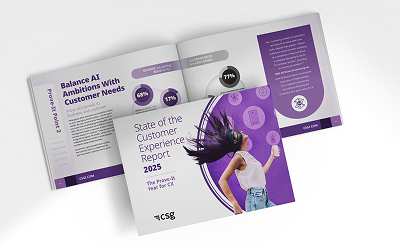Brands aren’t just experimenting with emerging technologies like machine learning, generative AI (GenAI) or agentic AI anymore. They’re putting them to work.
Many have already launched AI use cases in customer experience to power smarter self-service and enhance customer interactions, and with results. More than a third (36%) of customer management leaders say CX-focused AI technologies have had at least a moderate positive impact on revenue, according to a CCW Digital Europe study.
Recognizing AI’s potential to boost revenue, business leaders now expect CX teams to integrate it into their customer experience strategies—yesterday. But many consumers aren’t as eager to embrace this technology for customer care.
There’s a clear gap between the eagerness of the business to implement AI, and the readiness of the customer to adopt it. If businesses ignore that gap, it could jeopardize their customers’ band loyalty.
Business Leaders Are Racing to Adopt AI in Customer Interactions
After much research and deliberation (and some wait-and-see) on AI, businesses are sprinting to harness CX-focused AI to boost revenue and cut operational expenses—or risk being left behind. According to a KPMG survey of 130 business leaders at companies with at least $1B in revenue, 97% reported measurable profitability, and 94% cited significant productivity gains from GenAI implementations.
Not surprisingly (given those outcomes), 60% of customer service and support leaders are under pressure to adopt AI, according to Gartner. That pressure sometimes starts with company investors. According to the KPMG survey, investor pressure to adopt AI technologies increased during Q1 2025.
Many organizations are stepping up, fast-tracking AI initiatives to meet rising expectations. More than 80% of customer care executives worldwide are investing in AI-supported tools or plan to do so soon, according to McKinsey. This includes experimenting with AI agents—autonomous or semiautonomous software entities that use AI techniques to perceive, make decisions, take actions and achieve goals in their digital or physical environments. Almost two thirds (65%) of KPMG survey respondents reported piloting AI agents in Q1 2025 (up from 37% in Q4 2024). However, relatively few organizations (11%) have begun fully deploying AI agents.
Keep in mind, not every industry has the same appetite for risk involving AI. We’ve found businesses in heavily regulated spaces (like healthcare and banking) to be more reluctant to unleash AI to interact with their customers or members, even as they seek ways to boost the productivity of their human agents.
What are CX leaders hoping to accomplish with AI? Respondents in the CCW Digital Europe survey reported these key reasons for increasing spending on CX-focused AI technologies:
- Improve customer service (84% of respondents)
- Drive business efficiencies (71%)
- Boost agent productivity (49%)
- Increase revenue (47%)
And they’re exploring a range of AI use cases in customer experience:
- Chatbots and virtual agents (68% of respondents)
- Automated workflow management (56%)
- Self-service automation (56%)
- Sales and marketing content (31%)
- Live chat/video chat (27%)
Clearly, there’s a widespread business imperative (read: pressure) to apply AI. But on the other side of these AI implementations in CX are the customers—who aren’t all ready to embrace the technology in their experiences with a brand.
The Customer Readiness Gap in AI Adoption
“Major disruptions are always painful, and the transition from a care paradigm dominated by human agents to one steered by AI technologies may be the biggest disruption in the history of customer service.” —McKinsey
Not all customers are ready for that transition. Brands that ignore this will risk losing those customers as they go full steam ahead on AI implementations in CX. Here’s why brands need to be thoughtful and practical about these implementations:
Some consumers flat-out don’t want AI interactions
A Gartner survey revealed that “64% of customers would prefer that companies didn’t use AI in their customer service,” and “53% of customers would consider switching to a competitor if they found out a company was going to use AI for customer service.” The challenge is that customers are still looking for the convenience and speed to resolution they can get by speaking directly with an agent.
Many still prefer live agents
One of the top concerns about AI in customer interactions is that it will become more difficult to reach a person (60% of respondents), according to the Gartner study. This aligned with findings in a KPMG survey, where the most-cited consumer concern about AI was not being able to interact with a human (52% of respondents).
This point is less surprising when we consider how much human interactions still matter to consumers, at least according to surveys. EY research found that “consumers have begun to increasingly value human interaction during their post-purchase journey.” Consumers said it’s extremely important to interact with humans during product returns and refunds (56% of respondents) and to discuss questions or concerns about a product they purchased (55%).
For years, businesses have been pushing customers toward digital adoption, and they’ve had to account for the lingering preference for human interactions. And they still do in the era of AI adoption.
Many people still don’t trust the technology
Certainly, AI adoption is increasing among consumers; it more than doubled from 2023 to 2024, with 38% of survey respondents saying they’ve experimented with Gen AI or used it for projects or tasks.
But among respondents familiar with or using GenAI, 70% said that AI-generated content makes it harder for them to trust what they see online. And 68% are concerned that AI-generated content could be used to deceive or scam them. Even people who regularly use AI may not trust it. Only 32% of regular AI users listed “trust” as one of the top two emotions they feel toward gen AI.
Hallucinations—where AI tools generate false information instead of acknowledging uncertainty—can create problems for customers and brands. For example, an AI chatbot recently invented a new company policy, mistakenly informing a customer that a software program only works on one device per subscription. The risk of hallucinations continues to give business leaders pause on AI interactions, especially in healthcare, financial services and other highly regulated industries. They’re concerned that a rogue chatbot could expose the organization to fines in addition to customer friction.
On top of all that, customers may leave a brand that doesn’t get AI right. More than three-quarters (76%) of telco customers said a frustrating experience with their provider’s AI-powered customer service would negatively impact their loyalty. Customers want personal experiences on their terms, across any channel, at any time.
How can you roll out AI in customer interactions to meet business goals—without alienating customers who aren’t ready for it?
5 Best Practices for Balancing Your AI Ambitions With Customer Needs
Follow these strategies to introduce AI in CX, reaping the business rewards while mitigating friction with your customer base.
1. Start small
Focus on quick wins where it makes sense to leverage AI, such as assisting customers with specific tasks. For example, use GenAI to create customer communications, including knowledge base entries or FAQs, that are reviewed for accuracy. According to EY research, the top types of AI-generated content that consumers trust are 1) tailored promotions and deals (61% of respondents) and 2) product purchase reminders (58%). Telco customers said they preferred AI tools that solve their issues faster (65%), offer 24/7 support (64%) and enable seamless handovers to human agents (61%).
2. Identify use cases
Align AI capabilities with CX goals—but start with the latter. Pinpoint specific breakdowns within your customer experience that, if fixed, would dramatically benefit customers, or areas where staff productivity could increase with the right AI assistance. To identify a specific use case:
- Use customer journey analytics to determine pain points in customer journeys such as paying bills.
- Determine how AI could reduce that friction by asking yourself questions like:
- Where could my customers benefit from contextual, personalized communications only AI could efficiently deliver?
- What areas would my staff’s productivity increase two- or threefold with the right AI assistance?
- Identify metrics (related to business goals) to evaluate the effectiveness of the AI intervention.
3. Use hybrid approaches
Employ AI to enhance—not replace—the human contact center experiences that many customers prefer. Six of 10 telco customers (61%) said that a top trait they looked for in an AI tool was a more seamless handover to a human agent. A top concern regarding AI-driven support—cited by 47% of respondents—was how long it takes to reach a human representative when needed.
Instead of focusing only on customer-facing AI, also consider using the technology for back-office or employee-facing applications, like equipping agents to provide better and faster support. When calls are routed to the right agent (through intent-based call routing powered by natural language processing), customers don’t waste time re-explaining their problem, and agents can work on complex, high-value issues.
4. Tell customers when and how you’re using AI
More than half (57%) of Americans say businesses could reduce their concerns about AI by being transparent about how they are using it, according to a Gallup poll. Companies can build trust when they clearly signal to customers when they’re interacting with an AI-powered agent.
5. Offer non-AI customer care options
Provide support through other channels for customers who don’t want to engage with an AI agent. Offer a live chat option and make it easy for customers to speak with a real person. Journey analytics can help you identify what communication channels customers prefer, including AI vs. human interaction channels.
Keeping AI Focused, Safe and On-Brand
Businesses can push forward with AI innovation while navigating the complex desires of their customers. But what about the highly regulated industries mentioned earlier? For organizations in those spaces, a rogue chatbot or other overbroad use case of AI could cause serious regulatory headaches in addition to damaging customer trust.
There are tightly controlled AI use cases that can still deliver highly personalized experiences at scale. Let’s take CSG Bill Explainer as an example. It’s a GenAI-powered bill explanation tool that clarifies billing charges and monthly changes. It eliminates customer confusion that often leads to late payments and costly, time-consuming calls to contact centers. The AI takes the billing and customer data the company has, and it uses it to deliver personalized explanations of the month-to-month statement changes in a microsite, offering a faster path to self-service resolution for customers.
Here’s what makes Bill Explainer a lower-risk, higher-impact approach to applying customer-facing AI:
Data-locked AI
Bill Explainer only uses monthly bill changes and doesn’t source data from the internet at large. This helps mitigate the risk of hallucinations in what needs to be a precise, accurate communication with customers.
Guarded intelligence
Bill Explainer is built on Azure’s OpenAI with strict content filters.
Controlled creativity
The solution has very low creativity settings, which also help mitigate off-topic or hallucinated answers.
Client-specific content only
The insights in the AI-generated content are based only on the data the business provides—it doesn’t draw from data from other businesses or users.
Brand-aligned messaging
The solution’s tone and wording can be customized to match the business’ brand voice.
These attributes ensure the AI “stays in its lane” as it interacts with customers, helping businesses balance innovation with risk.
Ace the Balancing Act of AI in Customer Interactions
The benefits of CX-focused AI are undeniable, and the moment to act is now. But as your business races to implement AI to enhance customer experience, it’s crucial to keep the customer front and center. Even the most advanced AI tools will fall short if customers reject them—or worse, abandon your brand entirely.
Move forward with purpose, employing AI solutions that bridge the gap between customer expectations and operational capacity.
Discover more strategies to deliver winning CX this year and beyond
Read the 2025 State of Customer Experience Report.










